
After the early phase centered around multirole frigates, the threat seen by the Politburo posed by the new USN nuclear attack submarines (and soon SSBN) prompted the definition of a new generation of decicated ASW Frigates built en masse with specialized armament and more modern sonars. After the Petya class, the sescond one of this type was called the Mirka class (Project 35) an austere type developed around its large four RBU 6000 rocket launchers and 240 rockets in reserve plus a remote adjustable depth charge and depth charge ASW stern rack or quintuple 16-in heavy acoustic torpedo tubes bank plus variations. When modernized these 18 vessels received a welcomed variable depth sonar. They were never exported and stayed active until 1989-90, the last discarded in 1992. #coldwar #sovietnavy #mirka #aswfrigate #sovietskyflot #frigate #antisubmarine
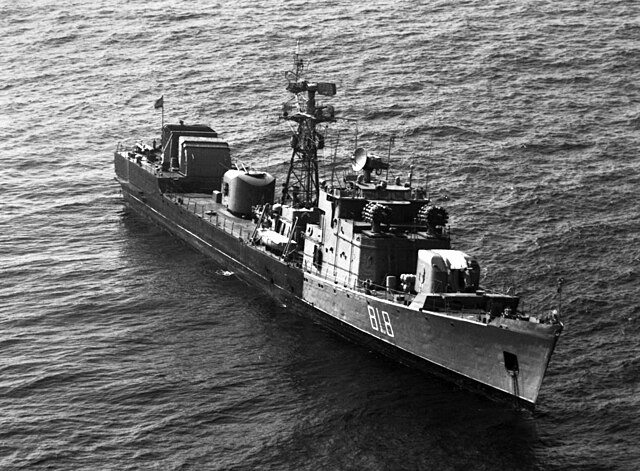
In short, the “Mirka” was the NATO reporting name but their original name was “Storozhevoi Korabl, Pro’yekt 35/35-M”.
They were fully dedicated to anti-submarine warfare in shallow waters, were similar to the Petya-class frigates (same hull, dimensions) but with a new, modified machinery with two shafts driven by diesels and gas turbines (CODAG) and propellers in tunnels (like water jets in an attempt to reduce noise). However in the end, the machinery proved noisy anyway, and unreliable.
Only 18 ships were built at Yantar, Kaliningrad.
Development
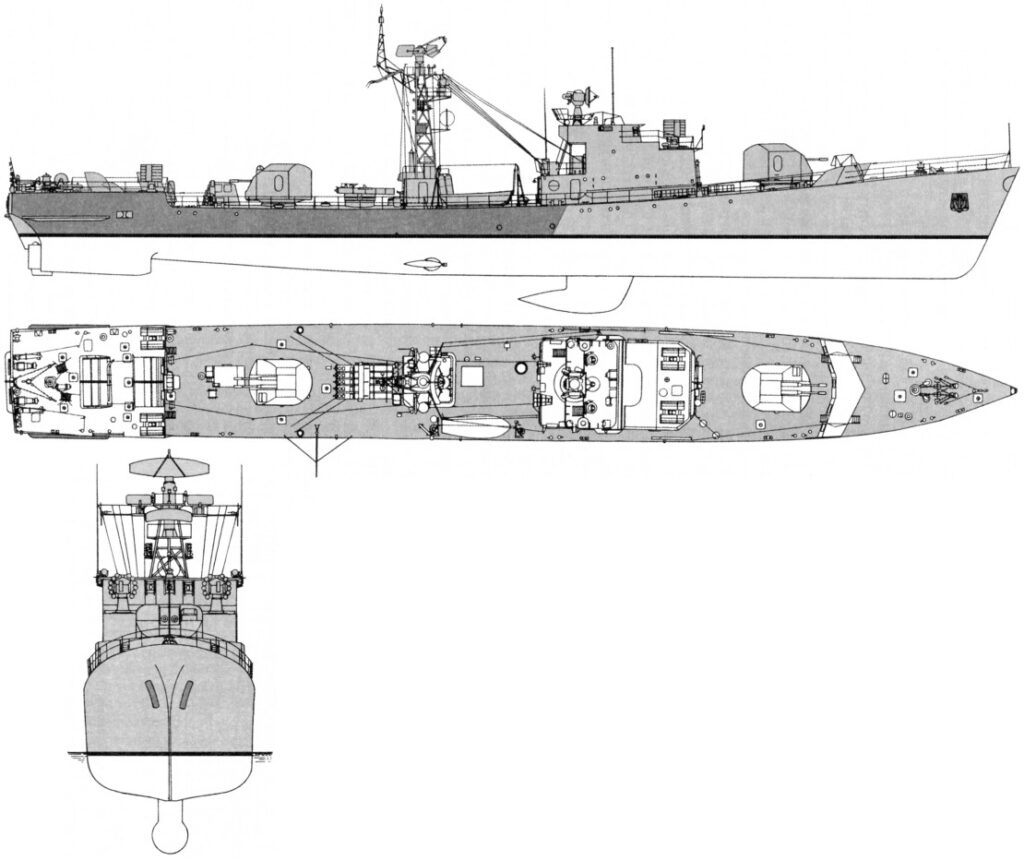
In 1957, the Zelenodolsk Design Bureau completed the development of the initial technical design specifications for a new version of Project 159 ASW Frigates, receiving the final project 35 designation. Chief designer N.Kh. Zhelyazkov was appointed to modernize Project 159, and he went for a new power plant style, already adopted for the Project 204 ships, with original hydraulic turbine propulsion. The fact is that the first experience in operating Project 159 ships (Petya) showed issues in using a three-shaft power plant, especially in economic mode or when searching for submarines. It was also discovered also that the impressive side shaft propellers created significant resistance, and worsened the global efficiency of what was intended for extra agility.
The design bureau has since then been searching for a powerplant variant devoid of these shortcomings while keeping the same hull to gain time in design development. The simplest solution was to create a two-shaft installation, with a reliable pair of diesel engines plus afterburning gas turbine on each shaft, using a common gearbox. However, this turned out to be impossible: In USSR at the time indeed, enegines manufacturing was monopolistic in the sense that each manufacturer tended to propose the gearbox that its produced with the engine. Noone was willing to create a gearbox compatible to the powerplant of another manufacturer. The situation remained the same until the collapse of the USSR in 1991.
The main power plant that was eventually chosen comprised two diesel engines driving the propellers in tunnels similar in appearance to water cannons, and two gas turbine compressors supplying air to the tunnel nozzles on the propellers at full stroke. Both had their own gearboxes. Experiments and calculations showed that it was possible in this matter to double the speed. At full speed on diesel engines alone, the Project 35 ships could reach 20 knots already, and when turning on turbines this went up to 34 knots (on paper). However in practice, this new powerplant did not lived up to expectations (see later). In the end, once approved, the design was approved in 1959 and construction was ordered the next year to xxx yard. In total 19 were built, given number in the SKR range. But as usual to confuse NATO intel, they were random numbers, changed often during their long career.
Design of the class
Hull and general design
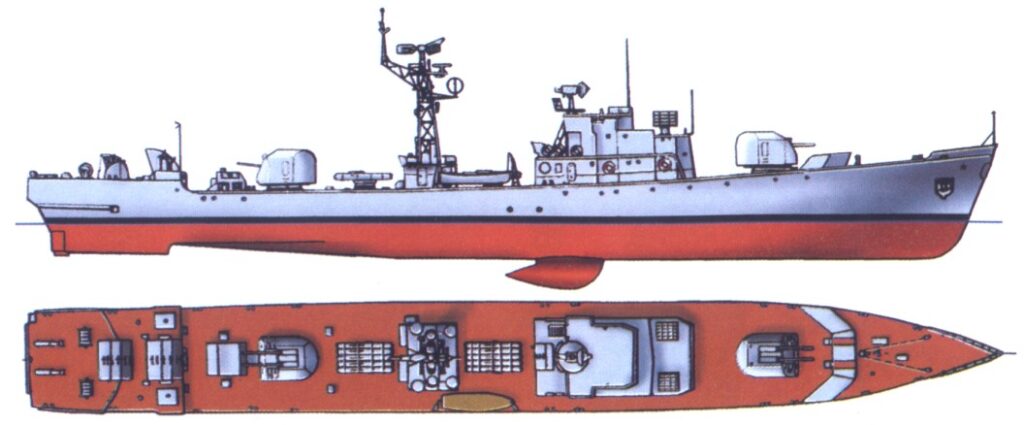
The ship’s hull was flush deck like the previous “Petya”, construction called for electric-welding, the bow was raised a lot to ensure seaworthiness, but unlike the previous Petya, she had only one mast and three superstructures. The main bridge superstrcture was also simplified and smaller, with an open bridge, a light framing above to enclos it partially from bad weather. The aft structures of the hull were raised above the deck level to accommodate the afterburning turbines. High-strength low-alloy steel SHL-4 was was used as main material. The hull was also assembled according to a longitudinal pattern with frames, floors and beams. To reduce trolling there were active and passive motion stabilizers. Minor and senior officers were housed in four sections. Nine officers were located in cabins in the bow. As for ASW protection (there was no armour), she was supposed to remain afloat two adjacent compartments were flooded. Due to the bulkheading, access hatched were located on the upper decks.
Powerplant
The power plant comprised two-shaft, and then diesel-gas turbine plus two 61B diesel engines (6,000 hp each) driving in turn propellers located in tunnel nozzles. The two GTK-D3 gas turbine compressors supplied air to the tunnel nozzles, accelerating rotation. This was quite a unique system at the time and quite promising, however what was not been sufficuently tested were the noise resulting of this and cavitation effects of the propellers.
The GTK-D3 gas turbine compressors had a high compression ratio, and were light weight with capacity of 18,000 liters. and service life of 2,000 hours. They provided an afterburner mode for the ship to to reach 34 knots. However in the end, the output was less than expected, and the level of noise, operation complexity and reliablility became an hinderance for all their career.
The auxiliary boiler however provided steam for other systems through generators so that she could operate all her systems while cold.
Despite her modest size, like her predecessor (Petya), her raised prow allowed good seaworthiness in waves up to 4 points. To reduce rolling, pitch stabilizers were installed on the ship. The powerplant also enabled long cruising range at economic speed (2,000 nautical miles). Tests carried out in 1964 confirmed the designer’s calculations of high speed of 34 knots, when trialled light in calm seas, however, with almost 12,000 hp more compared to the previous Petya, this was expected. However it was also ciriticized by other engineers later arguing that with a conventional power plant and standard propellers, this top speed could have reached 40 knots. But they especially raised the fact that this installation in practice was excessively noisy and difficult to operate. The noise in particular will give away her position to any submarine well in advance. In operation the unreliability was also partly the result of the four gearbox arrangement, not easy to coordinate and resulting in excessive wear and tear. Ultimately this contributed to curtailing the serie to just 18 ships.
Armament

While maintaining the main dimensions of Project 159, the Project 35 ship in architecture and layout resembled the Project 204 and Project 159-A in armment, with two twin universal 76.2-mm AK-726 gun mounts coupled with the radar “Turel”, and four RBU-2500 replaced RBU-6000 or a pair replaced by a second five-tube 400 mm torpedo tubes.
Main: 2×2 76mm AK-726
Of 2 twin stabilized 76-mm universal turret gun mounts AK-726 with a barrel length of 59 calibers. There were one guns in the bow and one in the stern of the ship. The turrets had light armor 5 mm thick; their disadvantage was poor ventilation, forcing them to fire with the hatches open. The rate of fire was 40-45 rounds/min. on the barrel followed by 3 min. cooling with sea water, and the survivability of the barrel reached 3000 shots. The barrels were loaded with 2 rounds in each clip; the clips were loaded manually. The installation calculation included 9 people (including 4 loading the feed elevator).
Using the D-67 remote drive, the AU turned left or right at an angle of up to 164° from the stowed position, and the vertical guidance angle ranged from -10° to +85°. The initial velocity of the projectile was 980 m/s, and the firing range at a sea or coastal target was up to 15 km using ship-based target detection equipment and the maximum ceiling was up to 11 km. The mass of the installation reached 26 tons. Artillery mounts were aimed automatically using remote control and manually. To control the fire of 76-mm artillery, a PUAO combined with the MP-105 Turel radar was installed.
4x RBU-6000 ASWRL
Of the 2 bomb launchers RBU-6000 “Smerch-2” with 12 barrels located on the sides in the bow, with a firing range of 1000 m, a depth of destruction of 450 m, 120 RSL-60 depth charges were used. The installation was aimed automatically from the Smerch-2 PUSB according to the data from the Vychegda GAS for targeted bombing. The RBU had its own loading system; the cellar with depth charges was located below deck; the bombs were fed to the loader by a special lift; the package of barrels, lowered by 90°, was rotated along the heading angle, automatically returning to the guidance mode after loading. The barrel pointing speed was 30 degrees/s in automatic mode and 4 degrees/s in manual mode. RBU could be used on ships with sea waves up to 8 points.
Torpedo Tubes
Of 2 five-tube 400-mm torpedo tubes PTA-40-159 with ammunition of 10 small-sized anti-submarine torpedoes SET-40 in the tube. The torpedo tube was equipped with a central device for firing control according to data received from the GAS control of the MG-311 “Vychegda”.
Of 2 high-speed acoustic guards (BOKA) for protection against acoustic torpedoes and mines. Their use was envisaged at speeds of 10…30 knots with sea waves up to 7 points.
Sensors

Instead of the Fut-N general detection radar, the Rubka radar was installed; the sonar systems remained the same: Titan and Vychegda.
The fire control system of the universal 76-mm artillery consisted of an artillery fire control device (AUAO) “Turel-35” including the central firing system D-67 (ballistic computer), which, based on incoming data from the MR-105 “Turel” radar, controlled two turrets, giving correct angles in vertical and horizontal plan. The second was the gyro stabilization system ensuring full stabilization when rolling. There was a preselector for moving targets, and noise protection.
Target designation used the Fut-N general detection radar. After receiving target designation, pointing was assisted by the MR-105 Turel firing radar.
The MP-105 “Turel” fire control radar usde decimeter wave range, making it possible to determine range and track surface, air and coastal targets. It automatically tracked targets at a range of up to 55 km and made it possible to select moving targets and detect an air target at a range of up to 150 km.
There was also a Fut-N target designation radar, Vaigach navigation radar, Nichrome state identification equipment, Bizan-4B RTR radar, MG-312 Titan all-round sonar and MG-311 Vychegda anti-submarine weapon control sonar. The radio direction finder was the ARP-50R, and BIUS “Tablet-35”.
The Fut-N target designation radar of the decimeter wave range made it possible to detect air and surface targets and transmit data about them to the fire control system of 76-mm machine guns.
The Vaygach navigation radar illuminated the surrounding and provided navigational situation awareness, solving navigation problems. The 3.2-centimeter wave station had range scales with intervals: 0.5/0.25, 1/0.25, 2/0.5, 4/1, 8/2, 16/4, 32/8, 64/8 and an indicator with a CRT with a diameter of 310 mm. The slot-type antenna was placed on a mast and had a rotation speed of 19 rpm. The width of the antenna radiation pattern ranged from 0.5 and in the horizontal beteween 1 and 0.7 °, vertical up to 20° with a resolution of c20 meters.


Petya and Mirka class compared.
⚙ specifications |
|
| Displacement | 950 tons standard, 1,150 tons full load |
| Dimensions | 81.8 x 9.2 x 2.9m (268 ft 4 in x 30 ft 2 in x 9 ft 6 in) |
| Propulsion | 2 shaft CODAG gas turbines 30,000 hp (22,000 kW)+ 2 diesels 12,000 hp (8,900 kW) |
| Speed | 34 knots (63 km/h; 39 mph) |
| Range | 4,800 nm (8,900 km; 5,500 mi)/10 knots or 500 at 30 kts |
| Armament | 2×2 76 mm (3 in), 4 RBU-6000, 1×5 16-in ASWTTs |
| Sensors | Radar Don-2, Slim Net, Hawk Screech, Sonar Herkules |
| Crew | 98 |
Modifications
In 1970, the Zelenodolsk Design Bureau was issued a TTZ for the development of a modernization project and SKR pr.35 in order to strengthen anti-submarine weapons. This project provided for: removing the stern 400-mm torpedo tube, additionally placing 2 RBU-6000 (at the stern), and replacing the Titan sonar with Vychegda with new ones: the keel-mounted Platina-MS and the towed Ros-K ” During the period from 1973 to 1978, 8 ships were modernized. The ships that underwent modernization received the number pr.35-M (in the west – Mirka-II class).
The cost of this work was very high and, by and large, did not correspond to the increase in efficiency that was obtained. The use of a towed sonar produces an effect only at great depths, which were practically absent in the coastal waters of the USSR. In open and remote areas of the seas, where such depths prevail, the small size of the ships did not make it possible to effectively use a towed sonar in the prevailing waves in these areas.
Construction program. The lead ship, Project 35, numbered SKR-7, was laid down on January 26, 1964 at the Yantar shipyard in Kaliningrad. The ship was launched on March 23, 1962, and entered service on December 25, 1964. The entire series of 18 ships was built at the same plant, the last ship was delivered to the fleet in 1967.
Status as of 2005. In the USSR Navy, Project 35 ships were first classified as large hunters, then as MPK, and later as SKR. 13 ships became part of the Baltic Fleet, and the remaining five, having made an inter-fleet transition, joined the Black Sea Fleet. While performing combat service in the war zone in the Mediterranean Sea, assistance to the Egyptian armed forces was provided by SKR-48 (10/1/1969-31/1/1970), SKR-6 (1-6/31/1967, 1/1-31/12/1968 ), SKR-13 (1-31.6.1967, 1.10.1969-31.1.1970) and SKR-117 (1-31.6.1967, 1.8-31.12.1968, 1.10.1969 -31.1.1970).
The last ships of this series were decommissioned in 1990-1991, the longest serving ships were SKR-12, SKR-19 and SKR-84 – they were expelled from the Navy in 1992.
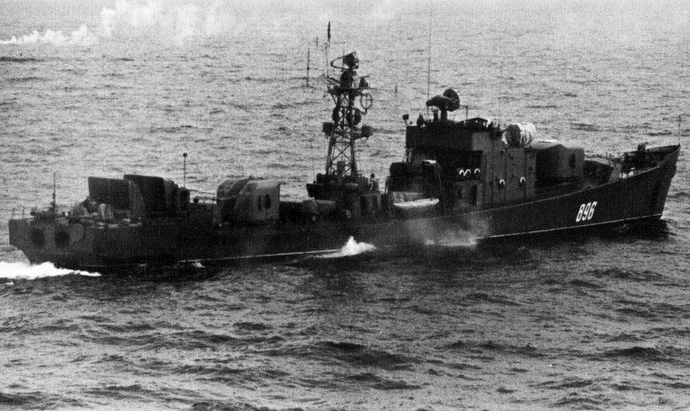
A Mirka I of the Black sea fleet shot in 1968 during combat operations for Egypt.
Read More/Src
Books
Conway’s All the World’s Fighting Ships 1947-1995
Links
and-kin2008.narod.ru/
russianships.info/
ru.wikipedia.org
archive.ph/ www.atrinaflot.narod.ru/2_mainclassships/06_skr_35/0_35.htm
navypedia.org/
war-book.ru/
additional photos on forums.airbase.ru/
Model Kits
Only found so far: 1/350 Soviet Union Mirka-Class Frigate (Project 35) CKP-83 1966
3D
 SKR-39
SKR-39

On 19.5.1966 she was known as PLK-39 and laid down on 26.5.1961 at Shipyard No. 820 Kaliningrad like the rest. Launched on June 23, 1962, comm. December 16, 1964. On January 22, 1965, she joined the DKBF and until May 19, 1966 remained in a subclass. On 10/1/1974 she was decomm. mothballed in Baltiysk and by January 30, 1985 was moved to Liepaja. On April 19, 1990, she was decommissioned and scheduled for dismantling and sale, stricken October 1, 1990 but sank during dismantling at berth in Liepaja, later raised, handed over to a Latvian company for scrapping.
 SKR-20
SKR-20
Until 19.5.1966 she was known as PLK-20. She was laid down on 26.1.1961, launched on March 23, 1962, commissioned 12/25/1964. Nothing notable in career but on 10-15.8.1976 a visit to Copenhagen (Denmark). She was decommissioned on 4.5.1989 and scheduled for disarmament, dismantling and sale, stricken on October 1, 1989.
 SKR-7
SKR-7
Until 19.5.1966 she was PLK-7. She was laid down by January 1961, launched 12/25/1961, commissioned on 12/29/1964. Like her sister SKR-20 she visited Denmark on 1-6.9.1978 (Copenhagen) and was decommissioned on 1.8.1987, stricken 10/1/1987 and scrapped in 1988-1989 at Glavvtorchermet base, Baltiysk.
 SKR-32
SKR-32
Until 19.5.1966 she was PLK-32. She was laid down on 21.3.1961, launched 15.5.1962, commissioned 12/29/1964, then decommissioned on 4.5.1989, stricken 12/1/1989, sold in 1990 to a Swedish company and scrapped.
 SKR-86
SKR-86
Until 19.5.1966 she was known as PLK-44. Laid down on 10.8.1961, launched 31.8.1962, she entered service on 12/31/1964. She started unit service and fleet exercizes by January 22, 1965, and on 24-29.6.1974 visited Turku, Finland. On 20-24.7.1978 she visited Gdynia in Poland. She was decommissioned on 19.4.1990 and stricken on 10/1/1990, but sank while being dismantled in the Baltic port and at berth due to he poor state of her hull plating.
 SKR-49
SKR-49
Until 19.5.1966 she was PLK-49. From 2.8.1968 she was named “IVAN SLADKOV”. She was laid down on 17.10.1961 and launched on June 15, 1962, commissioned on June 25, 1965. On 5-10.6.1974 she visited Gothenburg (Sweden). She was decommissioned on October 1, 1974, mothballed in Baltiysk, and from January 30, 1985 in Liepaja. She was stricken on 19.4.1990 but sank during dismantling at berth (you see a common pattern here).
 SKR-53
SKR-53
Until May 19, 1966 she was numbered PLC-53. She was laid down on 11/30/1961 and launched on December 10, 1962, commissioned on August 31, 1965 and by September 29, 1965, she changed homeport, making an inter-naval transition around Europe from Baltiysk to Sevastopol, and the black sea fleet. From December 17, 1982 to August 12, 1983 she was modernized as Mirka II at Sevmorzavod S. Ordzhonikidze yard in Sevastopol. She was decommissioned on 19.4.1990, stricken October 1, 1990, sold for BU in Sevastopol.
 SKR-24
SKR-24
She was known until May 19, 1966 as PLC-8. She was was laid down on 14.3.1962, launched 10.2.1963 and commissioned on September 30, 1965. On 5-10.6.1974 she visited Gothenburg in Sweden. On October 1, 1974, she was decommissioned and mothballed and first in Baltiysk, and from January 30, 1985, Liepaja. She was stricken on 19.4.1990, sold 10/1/1990 but sank during dismlantling in 1991 while berthed at Liepaja, later raised and scrapped in Latvia.
 SKR-83
SKR-83
Until 19.5.1966 she was known as PLC-55 and from 9.6.1980 called “60 years of KOLMSOMOL BIELORUSSIA”. She was laid down 20.7.1963, launched on December 10, 1963, entered service on September 3, 1966. On 10.28-29.1967 she visited Rostock in GDR (Eat Germany), and on 7.20-24.1978 Gdynia in Poland. From 6.1 to 7.3.1975, she was overhauled at Yantar Shipyard in Kaliningrad and became a Mirka II ship. She was decommissioned on 24.6.1991, stricken 10/1/1991 and… sank while dismantled at berth.
 SKR-84
SKR-84
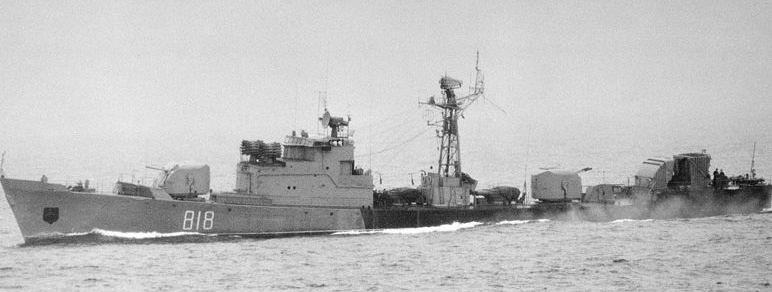
A Project 35 ship (SKR 618, a bogus number) in 1987
Until 19.5.1966 she was PLK-51. She was laid down on 17.5.1962, launched on April 10, 1963 and commissioned on 12/29/1965. By summer of 1966, she changed fleet, sailing around Europe from Baltiysk to Sevastopol, black sea fleet. On August 31, 1966 she was transferred to another service and from 2.2.1978 to 12.4.1979 she was modernized as Mirka II at S. Ordzhonikidze, Sevastopol and by December 17, 1985 to May 5, 1989 had her last refit at the Fleet Arsenal shipyard of Varna, Bulgaria. She was decommissioned on 07/03/1992 and on 12/31/1992, stricken and later scrapped in Sevastopol.
 SKR-48
SKR-48
Until 19.5.1966 she as knwon as PLK-48, laid down on 28.6.1962, launched on June 21, 1963, commissioned on 12/31/1965. By the summer of 1966, she was transferred from Baltiysk to Sevastopol and by August 31, 1966 was assigned to the KChF. From 10/1/1969 to 31/1/1970, she was on combat duty in a war zone on the Mediterranean, providing assistance to the armed forces of Egypt. From January 31, 1975 to January 30, 1978 and January 17, 1984 to May 22, 1986 she had two refits at Sevmorzavod S. Ordzhonikidze in Sevastopol. On 26-30.5.1982 she visited Tunis and on 19.4.1990 she was decommissioned and on August 1, 1990, stricken, scrapped in Sevastopol.
 SKR-12
SKR-12
Until 19.5.1966 she was known as PLK-12. She was laid down on 12.9.1962, launched on May 18, 1963, commissioned on 30.5.1966. On 29.7-2.8.1969 she visited Helsinki, and on 24-29.6.1974 she was in Turku, both on Finland. From April 6, 1973 to October 25, 1974, she had a short refit at KMOLZ in Kronstadt. On October 1, 1989, she was decommissioned and mothballed, laid up in Liepaja. She was stricken on 10/1/1992, but was left to rot and was discovered as such on June 1, 1994, after the withdrawal of Russian troops from the territory of Latvia, half-flooded at berth and later BU.
 SKR-19
SKR-19
Until 19.5.1966 she was PLK-19. She was laid down on 25.2.1963 and launched on July 27, 1964, entered service on June 30, 1966. On 1-6.9.1978 she visited Copenhagen and from April 24, 1974 to April 7, 1976, she had a major overhaul at the Yantar Shipyard in Kaliningrad. On 10/29/1992 she was decommissioned and stricken on 12/31/1992.
 SKR-35
SKR-35
Until 19.5.1966 she was PLK-35 and from 25.7.1967 “GANGUTETS”. She was laid down on 19.12.1962 and launched on September 27, 1963, commissioned on August 30, 1966. On October 28-29, 1967 she visited Rostock. On 19.4.1990 she was decommissioned and stricken by 10/1/1990 and… sank while dismantled at berth.
 SKR-6
SKR-6
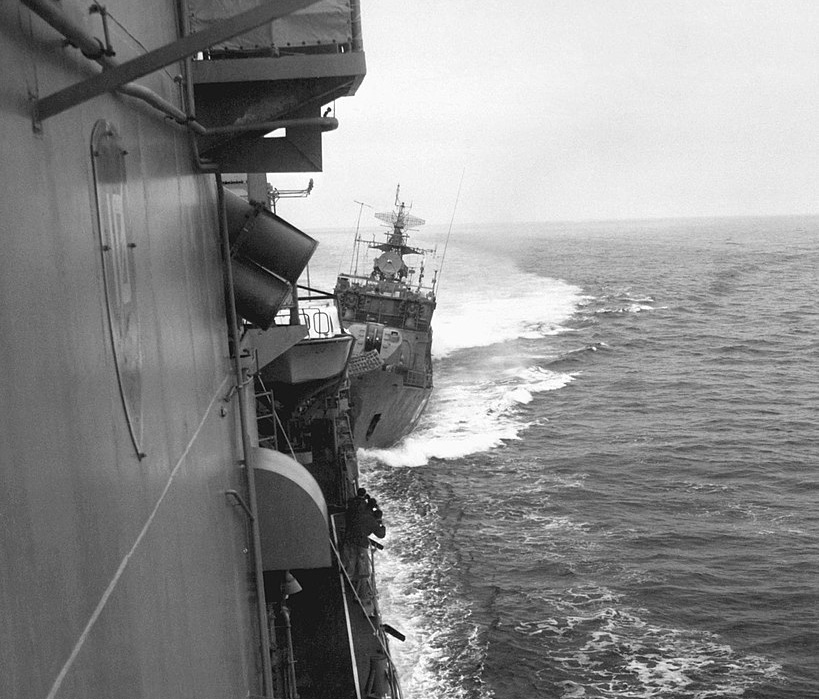
Until 19.5.1966 she was PLK-6. She was laid down on 10.4.1963 and launched on 6.2.1964, commissioned on November 30, 1966. On July 28, 1967, she was transferred to the Black sea fleet, transitioning around Scandinavia from Baltiysk to Sevastopol. On 1-31.1967 and 1.1-31.12.1968, she saw combat service in the Mediterranean, providing assistance to the armed forces of Egypt. From July 19, 1976 to March 2, 1978 and from January 23, 1984 to April 8, 1986 she had two refits at S. Ordzhonikidze Yard, Sevastopol. On 19.4.1990 she was decommissioned and by August 1, 1990, she stricken and scrapped in Sevastopol.
Note: The 1988 USS Caron incident (photo): Also called the “1988 Black Sea bumping incident”, it was one of many bumping incidents that happened as a reminder that the notion of “international waters” had variable geometry depending on what navy was asked for it… The USN went very close to the black sea fleet several times, and on 12 February 1988, the Ticonderoga-class cruiser USS Yorktown escorted by the Spruance-class destroyer USS Caron, conducted a passage exercise in the Black Sea, the destroyer closing 7.5 mi (12.1 km) off the Soviet shore, Yorktown staying at 10.3 mi (16.6 km). Black sea fleet Commander Mikhail Khronopulo received an order from Politburo’s Chernavin to “curb the passage” of these. Initially, the destroyer Krasnyy Kavkaz was tasked of this, but machinery issues left her to port, and instead Bezzavetnyy (Krivak-class frigate) was sent to “bump” Yorktown. In addition, The Soviet frigate SKR-6 (Captain Anatoliy Petrov) also sailed out to take care of USS Caron.
Caron was approached by SKR-6, while three minutes later, Yorktown was approached by Bezzavetnyy, both at deliberrate full speed, and for good measure Tupolev Tu-16 bombers closely shadowed the two ships. As the US warships clipped a corner of Soviet territorial waters at some point, both vessels that went ready for such occurences, sped up and deliberately bump their respective ships regardless of the consequences. There were few for the US ships due to their more massive size and inertia, but paint chipping. At 10:02 a.m local time SKR-6 bumped the port side aft of USS Caron and lightly dented her frame about 60 feet (18 m) from her bow. There was no injury and the event was filmes and photographed. Bezzavetnyy bumped Yorktown and then moved away whereas SKR-6 maintained close contact a bit longer before departing.
This was reported to the Europe CinC Admiral James B. Busey. Caron reported also the message in Russian and in clear by radio “Soviet ships have orders to prevent violation of territorial waters, extreme measure is to strike your ship with one of ours.” and replied “I am engaged in innocent passage consistent with international law.”. After this SKR-6 needed minor repairs to her bow as well.
 SKR-13
SKR-13
Until 19.5.1966 she was known as PLK-13. She was laid down on 31.5.1963, launched on October 13, 1964, and commissioned by December 28, 1966. On July 28, 1967, she was transferred to the Black sea fleet. She saw action on 1-31.6.1967 and from 1.10.1969 to 31.1.1970, in the Mediterranean to provided assistance to the armed forces of Egypt. She also had refits from 7.2.1977 to 21.9.1978 and from 17.12.1982 to 9.4.1984 at S. Ordzhonikidze Yard, Sevastopol. On 24.6.1991 she was decommissioned and on October 1, 1991, stricken, scrapped in Sevastopol.
 SKR-90
SKR-90
She was laid down on 10.2.1964, launched on November 30, 1964, commissioned on May 30, 1967. From July 31, 1978 to April 12, 1979, she was refited at Yantar Shipyard and by 19.4.1990 she was decommissioned; stricken on October 1, 1990 and BU.
 SKR-117
SKR-117
She was laid down on 10/15/1963, launched on February 25, 1965, commissioned on June 29, 1967. By July 1967 she was transferred to the Black sea fleet, making the transition around Europe from Baltiysk to Sevastopol (always an occasion to western planes to take good shoots of the class). She was deployed in combat twin on 1-31.6.1967, 1.8-31.12.1968 and from 1.10.1969 to 31.1.1970, providing assistance to the armed forces of Egypt. On 9-12.8.1969 she visited Varna in Bulgaria. She was refitted from February 25, 1974 to February 7, 1977 at S. Ordzhonikidze Yard, Sevastopol and from August 14, 1980 to August 24, 1981 in Kerch. On 19.4.1990 she was decommissioned and on October 1, 1990, she was stricken and BU in Sevastopol.

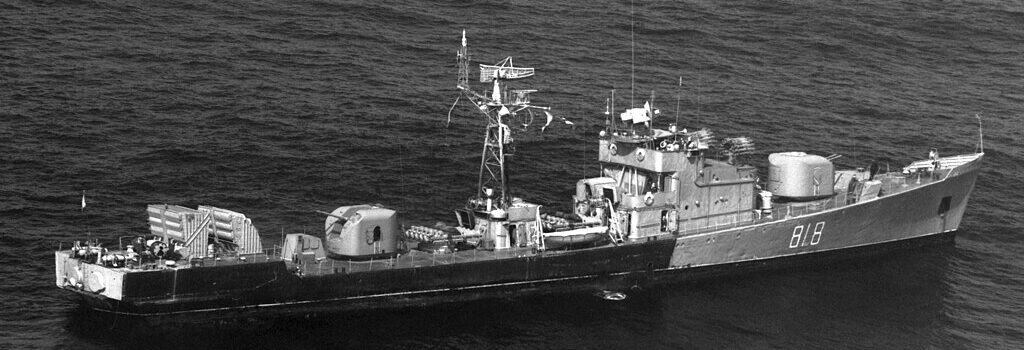

 Latest Facebook Entry -
Latest Facebook Entry -  X(Tweeter) Naval Encyclopedia's deck archive
X(Tweeter) Naval Encyclopedia's deck archive Instagram (@navalencyc)
Instagram (@navalencyc)





 French Navy
French Navy Royal Navy
Royal Navy Russian Navy
Russian Navy Armada Espanola
Armada Espanola Austrian Navy
Austrian Navy K.u.K. Kriegsmarine
K.u.K. Kriegsmarine Dansk Marine
Dansk Marine Nautiko Hellenon
Nautiko Hellenon Koninklije Marine 1870
Koninklije Marine 1870 Marinha do Brasil
Marinha do Brasil Osmanlı Donanması
Osmanlı Donanması Marina Do Peru
Marina Do Peru Marinha do Portugal
Marinha do Portugal Regia Marina 1870
Regia Marina 1870 Nihhon Kaigun 1870
Nihhon Kaigun 1870 Preußische Marine 1870
Preußische Marine 1870 Russkiy Flot 1870
Russkiy Flot 1870 Svenska marinen
Svenska marinen Søværnet
Søværnet Union Navy
Union Navy Confederate Navy
Confederate Navy Armada de Argentina
Armada de Argentina Imperial Chinese Navy
Imperial Chinese Navy Marinha do Portugal
Marinha do Portugal Mexico
Mexico Kaiserliche Marine
Kaiserliche Marine 1898 US Navy
1898 US Navy Sovietskiy Flot
Sovietskiy Flot Royal Canadian Navy
Royal Canadian Navy Royal Australian Navy
Royal Australian Navy RNZN Fleet
RNZN Fleet Chinese Navy 1937
Chinese Navy 1937 Kriegsmarine
Kriegsmarine Chilean Navy
Chilean Navy Danish Navy
Danish Navy Finnish Navy
Finnish Navy Hellenic Navy
Hellenic Navy Polish Navy
Polish Navy Romanian Navy
Romanian Navy Turkish Navy
Turkish Navy Royal Yugoslav Navy
Royal Yugoslav Navy Royal Thai Navy
Royal Thai Navy Minor Navies
Minor Navies Albania
Albania Austria
Austria Belgium
Belgium Columbia
Columbia Costa Rica
Costa Rica Cuba
Cuba Czechoslovakia
Czechoslovakia Dominican Republic
Dominican Republic Haiti
Haiti Hungary
Hungary Honduras
Honduras Estonia
Estonia Iceland
Iceland Eire
Eire Equador
Equador Iran
Iran Iraq
Iraq Latvia
Latvia Liberia
Liberia Lithuania
Lithuania Mandchukuo
Mandchukuo Morocco
Morocco Nicaragua
Nicaragua Persia
Persia San Salvador
San Salvador Sarawak
Sarawak Uruguay
Uruguay Venezuela
Venezuela Zanzibar
Zanzibar Warsaw Pact Navies
Warsaw Pact Navies Bulgaria
Bulgaria Hungary
Hungary

 Bundesmarine
Bundesmarine Dutch Navy
Dutch Navy Hellenic Navy
Hellenic Navy Marina Militare
Marina Militare Yugoslav Navy
Yugoslav Navy Chinese Navy
Chinese Navy Indian Navy
Indian Navy Indonesian Navy
Indonesian Navy JMSDF
JMSDF North Korean Navy
North Korean Navy Pakistani Navy
Pakistani Navy Philippines Navy
Philippines Navy ROKN
ROKN Rep. of Singapore Navy
Rep. of Singapore Navy Taiwanese Navy
Taiwanese Navy IDF Navy
IDF Navy Saudi Navy
Saudi Navy Royal New Zealand Navy
Royal New Zealand Navy Egyptian Navy
Egyptian Navy South African Navy
South African Navy






























 Ukrainian Navy
Ukrainian Navy dbodesign
dbodesign
In War Thunder this things are nearly invincible. Amount of damage they can take is ridiculous.